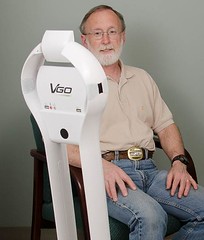VGo Robots will be Making the Rounds with Nurses
VGo units will be taken by VNAVNH nurses to homes of patients in the group’s home care and hospice services to allow medical specialists in other locations to have live consultations about the case
By David Brooks | July 29, 2012 | NASHUA – Robots from the Nashua company VGo will soon be accompany

ing visiting nurses on their rounds in western New Hampshire and parts of Vermont, the latest expansion into medical arenas by the company’s “telepresence ” devices.
“We have found tremendous interest in health care,” said Ned Semonite, vice president of product management and marketing for VGo Communications. The return on investment “comes pretty quickly for that industry. We have systems in hospitals, skilled nursing facilities, clinics.”
Visiting Nurse & Hospice of Vermont and New Hampshire has leased four VGo robots as a pilot program. They will be taken by nurses to homes of patients in the group’s home care and hospice services to allow medical specialists in other locations to have live consultations about the case.
“With specialists, it’s difficult to have them get to all our patients, some of whom are pretty remote,” said Craig Amoth, director of development and community relations for the group, which serves 100 towns in the Connecticut Ri
ver Valley, from areas to the west of Keene north through Plymouth, plus roughly the eastern third of Vermont.
“It’s really to enhance the expertise of the nurse who will be there in the home.”
This pilot program is designed to test how well the robots can help patients without raising costs, partly so the association can get their use covered by insurance payments.
“If we can show the efficacy, we can talk to Medicare, Medicaid, third-party insurers, to say, ‘Look at how we can impact patient outcomes and reduce costs,’ ” Amoth said.
He said the association will cover the cost of the pilot test.
“The pressure to bring health care costs into line with reimbursements means we’re always looking for ways to increase efficiency as well as improve outcomes,” Amoth said.
VGo robots are basically wireless video-conference screens and cameras placed on remote-controlled, rolling platforms.
A robot’s operator can see, listen to and talk with people far away via cameras and microphones, as is done with video-conferencing websites, and remotely move the screen and camera around the building or change its angle and zoom, increasing interaction.
The result is sometimes called “telepresence” because it give an illusion of the person actually being present.
VGo robots have various attachments that can, among other things, dispense medication on command from the remote operator.
Their batteries are recharged via units plugged into the wall; the robots must return to the charging station occasionally.
A home must have a WiFi Internet router and a broadband connection for the VGo units to operate there.
“There are a few places here and there where we won’t be able to deploy them, but what we’re finding is that more and more homes are adopting this,” Amoth said. “We don’t think it’s going to be a limitation for us.”
A few companies made similar products, most notably industry leader iRobot, of Waltham, Mass., which drew a lot of publicity last week with a rollout of its own health care telepresence robot for hospitals.
Semonite noted the cost difference between the two firms’ robots. VGo units can cost less than $6,000.
“They’re building a Cray computer, if you will, and we’re building a PC for the masses,” he said. “We emphasize price and affordability; ensuring units are everywhere, as opposed to specialized applications.”
Among the health care facilities that have used VGo robots are Children’s Hospital Boston, which sends them home with some patients for a few weeks to help doctors keep an eye on recovery.
